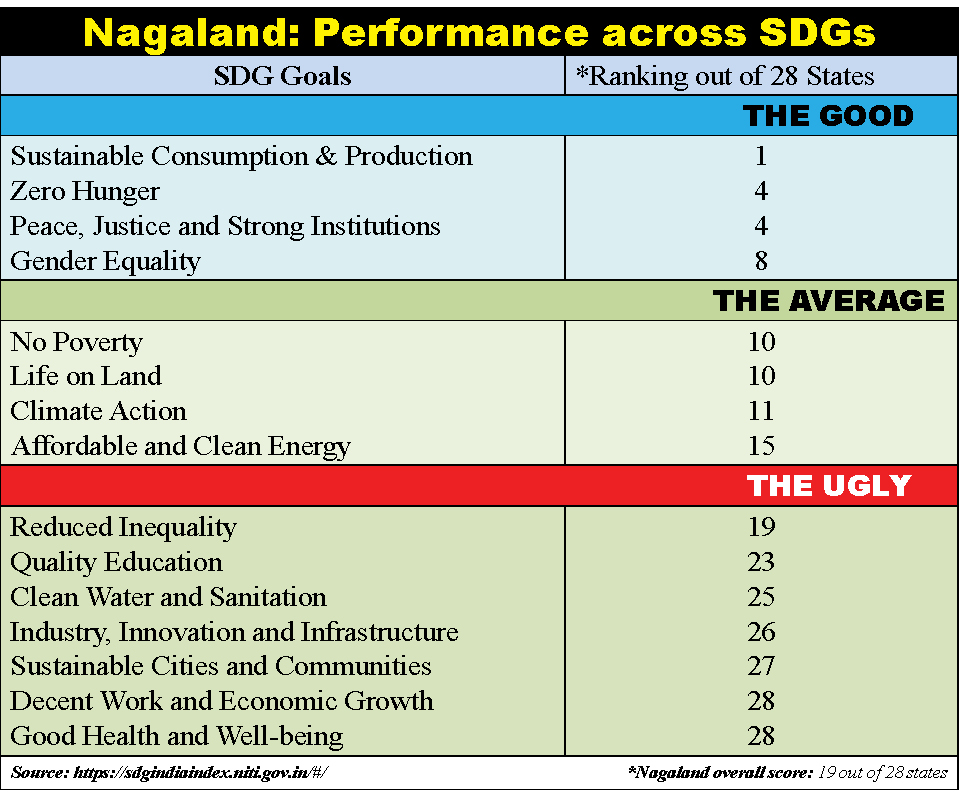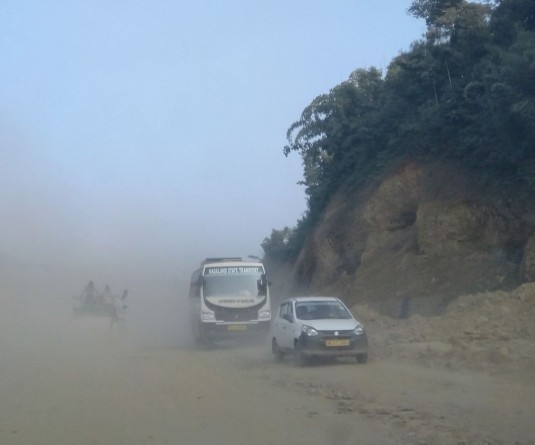Nagaland’s SDGs report card: The Good, the Average and the Ugly

Morung Express News
Dimapur | February 6
What is Nagaland’s status towards achieving the United Nations' Sustainable Development Goals (SDGs) targets by 2030? In which areas, the state is performing well or lacking behind and what are the goals that need urgent course correction?
As members of the 13th Nagaland Legislative Assembly (NLA) congregate for its 5th session from February 7 to 15 to chalk out plan for the next financial year, The Morung Express presents a snapshot of the State’s status as reflected in the SDG India Index 2019-20, a dashboard developed by NITI Aayog and launched on December 30, 2019.
According to NITI Aayog, the Index has been constructed spanning across 16 out of 17 SDGs tracking the progress of all the States and Union Territories (UTs) on a set of 100 National Indicators derived from the National Indicator Framework.
The SDG India Index 2019-20 is intended to provide a holistic view on the social, economic and environmental status of the country and its States and UTs, the National Institute of Transforming India (NITI) Aayog maintained.
The index represents the progress made by India’s states and union territories towards achieving the 2030 SDG targets, it added.
Nagaland overall score
Overall, Nagaland, who ranked 19 out of 28 states, saw its total score increase from 51 in 2018 to 57 in 2019. It was, however, marginally below the national score of 60.
Kerala with 70 points was at the top followed by Himachal Pradesh and Andhra Pradesh. Along with them, 7 other states and UTs - Chandigarh, Goa, Himachal Pradesh, Karnataka, Kerala, Puducherry, Sikkim, Tamil Nadu, and Telangana were bracketed as ‘Front Runners’ to achieve the SDGs.
Nagaland and the other remaining States and UTs were bracketed as ‘performers.’ So far there is no achiever from India. Among the states, Bihar lies at the bottom of the index, followed by Jharkhand and Meghalaya.
Nagaland’s performance, in comparison with others, thus can be considered as mediocre. How did the state perform on individual goals then? We start with the Good.
The Good:
Out of 17 indexes, Nagaland was ranked first in ‘Sustainable Consumption & Production’ by scoring 100, out of 100. The indicators under this include groundwater withdrawal against availability (%), usage of nitrogen fertilizer out of total NPK (Nitrogen Phosphorous Potassium), per capita hazard waste generated etc.
While it declined slightly from 2018, Nagaland’s performance in ‘Zero Hunger’ is still robust and slotted 4th among states. Indicators like population living below national poverty line, households with any usual member covered by any health scheme or health insurance, employment under MGNREGA are measured under this.
Another high performing index was ‘Peace, Justice and Strong Institutions,’ where the state was ranked 4th among the states, though there was a slight decline in score from last year. It includes indicators such as reported murders per 1 lakh population, physical psychological or sexual violence, crimes against children, and victims of human trafficking.
While there was no improvement between 2018 and 2019 on Gender Equality, the state was ranked high at 8th. Sex ratio at birth, crimes against women and female to male ratio of average wage/salary are some indicators under this index.
The Average:
On poverty reduction, Nagaland was ranked 10th.
Another index where Nagaland performed relatively well was ‘Climate Action’ and was ranked 11th. Loss of human lives due to extreme weather events, and Co2 saved from LED bulbs per 1000 population etc are measured under the index.
Again on ‘Life on Land,’ which includes indicators on total land area covered under forest, tree cover, and decadal change in extent of water bodies within forests, the state scored high and stood at 10th position.
On ‘Affordable and Clean Energy’ with indicators like area of households electrified (%) and households using clean cooking fuel (LPG), the state was ranked 15 among 28 states.
The Ugly:
While the ‘average’ portion of SDGs could use rectification, it is the “Ugly’ side which needs urgent policy intervention. Almost all the indicators under this category directly reflects the state of affairs in Nagaland
For instance, take the case of ‘Good Health and Well-being’ index, where Nagaland was ranked last among 28 states. The indicators of measurement include maternal mortality ratio, proportion of institutional deliveries, under-five MMR, immunisation, health workers etc.
On ‘Decent Work and Economic Growth’ indicating values such as the annual growth rate of Net Domestic Product, ease of doing business score, unemployment rate (%) and labour force participation rate (%) etc, Nagaland was 2nd last.
Again, the ‘Sustainable Cities and Communities’ index with indicators such as houses completed under PMAY, urban households living in slums, door to door waste collection, waste processed etc, it was 27th among 28 states.
In ‘Industry, Innovation and Infrastructure’ which measured all-weather roads, manufacturing employment, mobile tele density etc, the state stood at 26th position.
With regard to ‘Clean Water and Sanitation’ the state was 25th.
The ‘Quality Education’ indicator, which measures enrolment ratio, out of school children, drop-out rate, gender parity index for higher education etc, is also worrisome.
The state ranked 23rd out of 28 states here.
Last, but not the least, for the goal of ‘Reduced Inequality,’ which looks at indicators such as growth rates of household expenditure per capita among the bottom 40%, coefficient of household expenditure, proportion of seats held by women in Panchayati Raj Institutions, etc, it stood at 19th.
The SDGs, also known as the Global Goals, according to the UN, was adopted by all its Member States in 2015 as a “universal call to action to end poverty, protect the planet and ensure that all people enjoy peace and prosperity by 2030.”
Both the ‘Average’ and’ Ugly’ portion of Nagaland’s SDGs index pertain to indicators having direct implication on the welfare of the people. The upcoming NLA session could be an opportune platform to chalk out strategies to improve upon the performance across the SDGs.







